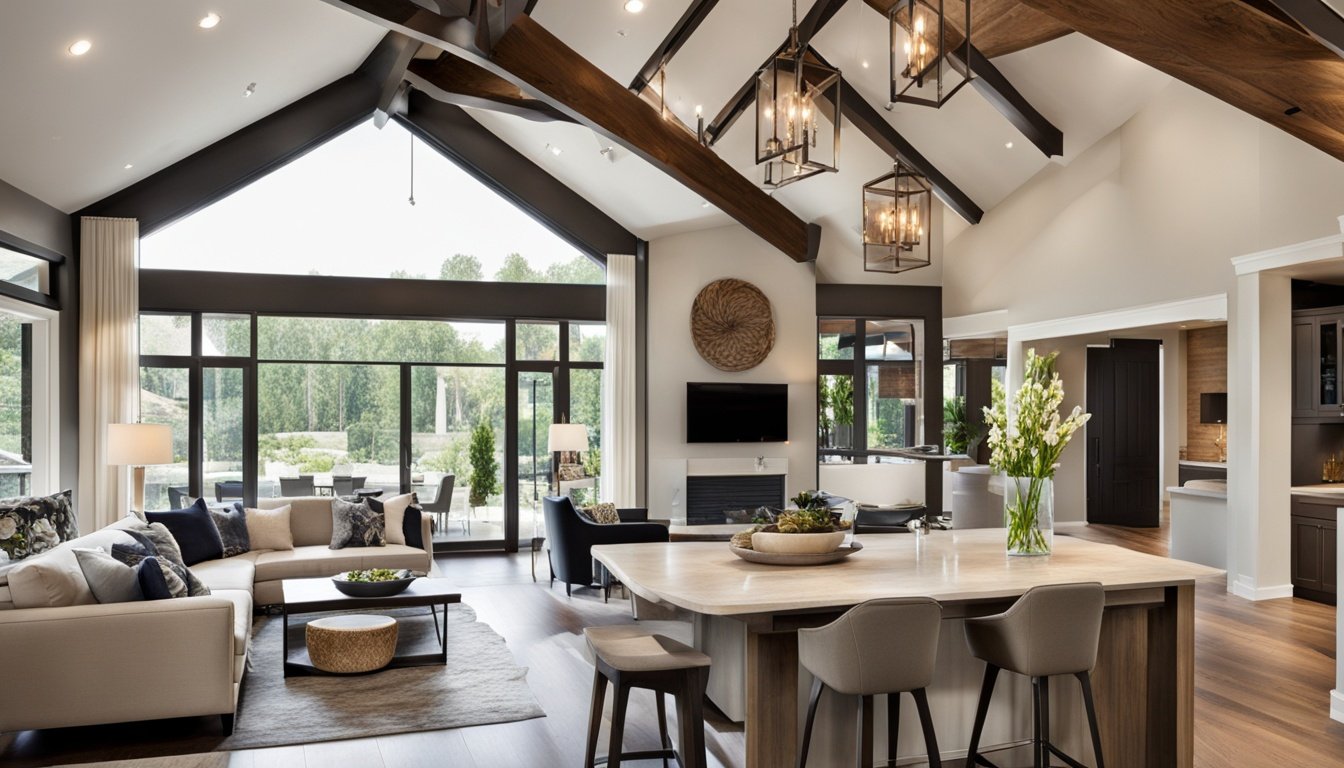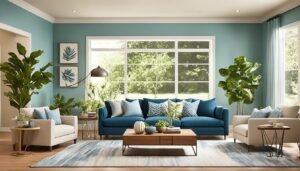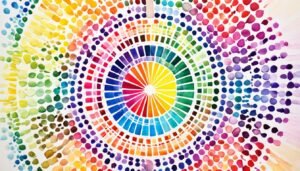
Get ready for a surprising fact: only 5% of interior design talk includes “bespoke creations”. This shows how crucial it is to know the growing language of home decor. You’ll come across terms like “eclectic room” and “Mediterranean aesthetic” as you explore this field.
Are you looking to upgrade your living space, improve your design skills, or just love interior design? This guide is for you. It will give you the key words you need to understand modern design, up-to-date furniture trends, and sustainable materials for home decor. Let’s start this journey together.
Key Takeaways
- Understand the variety of words used in interior design, from bespoke creations to eclectic rooms.
- Master the language to describe your design vision, including different styles like modern, contemporary, and minimalist.
- Look into the trends of eco-friendly materials and smart home tech, and their impact on future interior design.
- Get to know the insights required to keep up with home interiors changes, empowering you to renovate your home confidently.
- Learn ways to improve your design language, such as making mood boards and talking effectively with clients and suppliers.
Mastering the Language of Home Decor
Exploring interior design means diving into its terms and phrases. Knowing these is key for good talks and understanding design principles. They include balance, proportion, contrast, focal point, and scale. Learning these helps you share what you like, get design concepts, and work with experts for the look you want.
Key Terms and Phrases Used in Interior Design
The world of interior design covers many design styles, each with its words. If you love modern, traditional, eclectic, or minimalist looks, knowing the right terms is crucial. It lets you talk about what you prefer and pick a design that fits your dream well.
| Design Style | Key Characteristics | Commonly Used Terms |
|---|---|---|
| American Colonial | Furniture from American colonies before the revolution. It includes simple, homemade pieces. There are also American twists on formal European designs. | Craftsmanship, Americanized, Formal, Rustic |
| American Country | These designs go back to early American settlers. They are known for their simple and rustic feel. | Simplicity, Rustic, Handmade |
| American Frontier (American Primitive) | A type of furniture from the late 1700s to 1800s. It was made for the western frontier. They used woods like ash and pine, often painting the pieces black or in bright colors. | Frontier, Primitive, Painted, Primary Colors |
| Arts & Crafts | This style was against the mass Victorian furniture in the late 1800s to 1920s. It focused on high-quality work. | Craftsmanship, Handmade, Reaction, Victorian |
| Art Deco | A popular look in the 1920s and 30s, full of geometric forms. Items often had rounded fronts, wood with chrome, and glass parts. | Geometric, Rounded, Chrome, Glass |

Learning the words of interior design lets you talk about what you like. This makes it easier to work with design pros. Together, you can make a place that shows your unique style.
Color Terminology and Its Impact on Design
Color is key in interior design, influencing everything from mood to visual appeal. It’s important to know the terms around color. This knowledge helps designers create spaces that speak to people’s feelings.
Hues, Saturation, and Tones
The color wheel is where it all begins. You need to get hue, saturation, and tone. Hue is the color’s name like red, blue, or yellow. The saturation is how vibrant that color is. And the tone shows if the color is light or dark, making it a tint or shade.
Complementary Colors and Monochromatic Schemes
Knowing how colors relate is important. Complementary colors stand against each other on the wheel. They bring a space to life by creating a bold contrast. On the flip side, monochromatic schemes focus on one color. They use various tints, shades, and tones of that color to keep a space calm and unified.
Learning the color language helps designers share their ideas clearly. This skill lets them play with different color groups and make spaces that feel just right.

“Colour is a power which directly influences the soul.” – Wassily Kandinsky
Current Home Interiors Terminology
Materials and Finishes: Speaking the Language of Textures
The materials and finishes in your home make a big difference. They create depth and interest. It’s key to know about different textures for good design choices.
Textures range from rough to smooth. Each has a unique quality. Knowing how they work together is crucial for stunning spaces.
Let’s look at some common terms:
- Rough textures, like exposed brick or weathered wood, give a space a rough and tough feel.
- Smooth finishes, such as polished marble, add elegance.
- Shiny materials bring glamour with light reflections.
- Matte textures, like soft fabrics, offer a calm look.
Knowing these terms helps in creating engaging designs. By mixing textures, you can add depth and character. This makes any room more interesting.
Whether you love cozy or modern, understanding textures is vital. It lets you turn boring spaces into something special. Your home can become a place that truly stands out.
Furniture and Accessories: Navigating the World of Design Terminology
Furniture and accessories form the heart of interior design. Knowing the words for different styles, materials, and features is key. By learning this design talk, you can express your style, work well with experts, and design your space with certainty.
Furniture Terminology
The furniture world is vast, with many words for its styles and parts. You’ll find terms for everything from a classic armchair to a modern barstool. Terms like bentwood and veneers help us see the work in each piece.
Accessory Terminology
Accessories make a room feel alive. Know words like artifact and curio for different types. This helps when picking textiles or upholstery to make your design really pop.
Furniture and Accessory Styles
Each design style has its own words, from French armchairs to Bentwood rockers. Learn about Art Deco and others to see their cultural impact on furniture and accessories.
| Furniture Category | Terminology Examples |
|---|---|
| Seating | Armchair, Barstool, Bergère, Club Chair, Chaise Lounge |
| Storage | Bookshelf, Breakfront, Cabinet, Credenza, Dresser |
| Decor | Artifact, Bassinet, Canopy Bed, Curio, Spindles |
Knowing furniture and accessory words lets you own your design choices. You can speak clearly about what you want and make spaces that show your unique style.
Becoming Fluent in the Language of Home Decor
Learning about interior design words is ongoing. It’s best done with mood boards. These boards let you see and share your design ideas. They help understand styles, textures, and colors better. By creating mood boards, you’ll know more about home decor terms and make your design ideas real.
Creating Mood Boards to Enhance Your Design Vocabulary
Mood boards are key for turning your ideas into visuals. Put together images, materials, and colors. This helps you play with different design elements and improve your design talk. You can learn about many design styles this way. And it makes talking about your design ideas with others much easier.
Tips for Effectively Communicating with Clients, Contractors, and Suppliers
Once you know your design terms, it’s time to talk with others in the design process. We’ll give you tips for chatting with clients, contractors, and suppliers. You’ll be able to explain your design ideas well. And know what they think to get the job done right. Understanding the design language makes projects smoother.
- Get what your client likes and wants.
- Show your design thoughts with mood boards and sketches.
- Listen to what others say. And think about adding their design tips.
- Learn the words contractors and suppliers use. It makes working together easier.
- Keep your talk clear and open. This is important for everyone to know what’s up.
Using these tips makes your design talk better. It helps connect your design dreams with what really happens. Knowing the home decor language is crucial for doing well in interior design.
“Effective communication is pivotal in interior design, enabling designers to interpret clients’ ideas and turn them into actionable plans.”
Conclusion
Understanding home interiors’ language is key for improving your living spaces and sharing your design ideas well. You will better express what you like, work with experts, and make your home look amazing.
This guide equips you with the needed knowledge to excel in home interiors. It allows you to upgrade your design abilities and craft spaces that mirror your style. Now, you’re familiar with the industry’s history, various styles, and using colors and space effectively.
Clear communication on design terms is crucial for working well with others on your home. Use your new skills to team up with builders, suppliers, and designers. Together, turn your living areas into personal oases that show off your style and unique design language. Start your journey towards a home that’s not just beautiful but truly reflects you.
FAQ
What are the key terms and phrases used in interior design?
How can I learn the vocabulary associated with different interior design styles?
What is the importance of understanding color terminology in interior design?
How can I learn the terminology associated with materials and textures in home decor?
What are the key terms used to describe furniture and accessories in interior design?
How can I use mood boards to enhance my design vocabulary?
What strategies can I use to effectively communicate with clients, contractors, and suppliers in the design process?
Source Links
- https://www.elledecor.com/design-decorate/interior-designers/g3355/interior-design-terms/
- https://www.decorilla.com/online-decorating/interior-design-styles-101/
- https://foyr.com/learn/types-of-interior-design-styles/
- https://www.whldesign.com/glossary.html
- https://www.andacademy.com/resources/blog/interior-design/what-is-interior-design/
- https://www.architecturaldigest.com/story/most-poular-interior-design-styles
- https://interiordesignstudent.com/study-notes/colour-in-interior-design/
- https://www.archdaily.com/935067/how-colors-change-the-perception-of-interior-spaces
- https://gharpedia.com/blog/colour-terms-used-in-home-interiors/
- https://www.julieannrachelle.com/blended-decor-blog/101-most-commonly-used-interior-design-words
- https://bobbyberk.com/whats-your-interior-design-style-a-breakdown-of-all-the-styles/
- https://www.architecturaldigest.com/story/contemporary-interior-design-101
- https://www.cherrypickindia.in/complete-guide-on-list-of-furnitures-for-home/
- https://decoroutdoor.com/blog/style-glossary/
- https://jgu.edu.in/blog/2024/02/26/what-is-interior-design/
- https://illustrarch.com/articles/18545-the-language-of-interior-design.html
- https://www.linkedin.com/pulse/12-skills-you-need-successful-interior-designer-clare-le-roy
- https://nlsnorwegian.no/how-to-talk-about-home-decor-in-spanish-25-interior-design-terms/
- https://en.wikipedia.org/wiki/Interior_design
- https://foyr.com/learn/how-to-use-line-in-interior-design/
- https://www.designcafe.com/blog/home-interiors/importance-of-interior-design/






No comment yet, add your voice below!